Standards Worldwide
Standards Worldwide
Phone +49 30 58885700-07

Standard [CURRENT]
ASTM E 2912:2017
Standard Test Method for Fire Test of Non-Mechanical Fire Dampers Used in Vented Construction
- Publication date
- 2017
- Original language
- English
- Pages
- 19
- Publication date
- 2017
- Original language
- English
- Pages
- 19
- DOI
- https://dx.doi.org/10.1520/E2912-17
Product information on this site:
Quick delivery via download or delivery service
Buy securely with a credit card or pay upon receipt of invoice
All transactions are encrypted
Short description
1.1 This fire-test-response standard assesses the ability of non-mechanical fire dampers used in vented construction in its open state to limit passage of hot gases, radiation, and flames during a prescribed fire test exposure. The fire exposure condition in this test method is sudden direct flame impingement, which produces these hot gases, radiation, and flames. Note 1: Non-mechanical fire dampers can be used in vented construction. Vented constructions may be parts of buildings including walls, floors, ceilings and concealed spaces and cavities used for air transfer and to allow ventilation in structures without ductwork. Non-mechanical fire dampers can be located adjacent to combustible construction or materials and situated in exposed or concealed locations, or both. Unlike typical fire resistive assemblies, vented construction uses non-mechanical fire dampers to allow air transfer without the use of ducts. Resistance to flame, radiation, and hot gases may be requirements when direct flame impingement is a credible risk, or when no penetration of flames is required by the authority having jurisdiction, or both. The proposed test method provides procedures that enable an assessment of this direct flame impingement on non-mechanical fire dampers. This test method does not alter any requirements for non-mechanical fire dampers used in fire resistance rated construction and assemblies. 1.2 This fire-test-response standard is intended to provide a means to assess the reaction of a non-mechanical fire damper used in vented construction to sudden direct flame impingement, or as a supplement to existing fire-resistive test methods, or both. 1.3 This test method does not circumvent or eliminate the fire resistance rating requirements for construction. The fire resistance rating of construction shall be tested in accordance with published fire-resistance test standards as appropriate for the relevant application of the construction, or as required by the authority having jurisdiction (regulatory authority), or both. Non-mechanical fire dampers shall be tested to the appropriate fire-resistive test standards required for their application in order to determine a fire resistance rating in those constructions. Note 2: Some of the major international standards development organizations (SDO) include, but are not limited to, ASTM International, CEN, ISO, UL, and ULC. Some examples of standards employing standard time-temperature curves for fire exposure used to determine a construction's fire resistance rating include, but are not limited to, the following: Test Methods E119 , E814 , E1966 , E2307 , UL 10B, UL 10C, UL 555, UL 555C etc. The term "authority having jurisdiction" is defined in Practice E2174 . 1.4 This test method specifies the fire exposure conditions, fire test protocol, and criteria to evaluate an open state. Note 3: There are currently no published test methods (nationally or internationally) that address the application of sudden direct flame impingement on non-mechanical fire dampers used in vented construction. In the European Union (EU), CEN (European Committee for Standardization) has very recently started a work item to address reaction to sudden direct flame impingement on non-mechanical fire dampers. Also, in the EU, some countries have used large scale tests with 5MW fire exposures to assess test specimens' reactions to sudden direct flame impingement as part of the entire building construction. Standard time-temperature curves used to control gas-fired furnaces do not ensure a sudden direct flame impingement on the test specimen, which this test method is designed to do. A post flashover condition, the spontaneous combustion of materials, ignition of a highly combustible material acting as the source of the fire (for example, stored cleaning solutions or fuels) or the location of materials can create a fire scenario resulting in a sudden direct flame impingement. 1.5 Results generated by this test method provide the following information: 1.5.1 the open state fire performance of vented construction, and 1.5.2 the non-mechanical fire damper's fire-test-response characteristic when exposed to sudden direct flame impingement. 1.6 This test method does not provide quantitative information about the test assembly related to the leakage of smoke, or gases, or both. 1.7 This test method does not apply to a test assembly having other components than those tested. 1.8 This standard is used to measure and describe the response of materials, products, or assemblies to heat and flame under controlled conditions, but does not by itself incorporate all factors required for fire hazard or fire risk assessment of the materials, products, or assemblies under actual fire conditions. 1.9 The text of this standard references notes and footnotes which provide explanatory material. These notes and footnotes (excluding those in tables and figures) shall not be considered requirements of this standard. 1.10 The values stated in SI units are to be regarded as standard. No other units of measurement are included in this standard. 1.11 Fire testing is inherently hazardous. Adequate safeguards for personnel and property shall be employed in conducting these tests. 1.12 This standard does not purport to address all of the safety concerns, if any, associated with its use. It is the responsibility of the user of this standard to establish appropriate safety, health and environmental practices and determine the applicability of regulatory limitations prior to use. 1.13 This international standard was developed in accordance with internationally recognized principles on standardization established in the Decision on Principles for the Development of International Standards, Guides and Recommendations issued by the World Trade Organization Technical Barriers to Trade (TBT) Committee.
ICS
13.220.99
DOI
https://dx.doi.org/10.1520/E2912-17
Also available in
Loading recommended items...
Loading recommended items...
Loading recommended items...
Loading recommended items...
